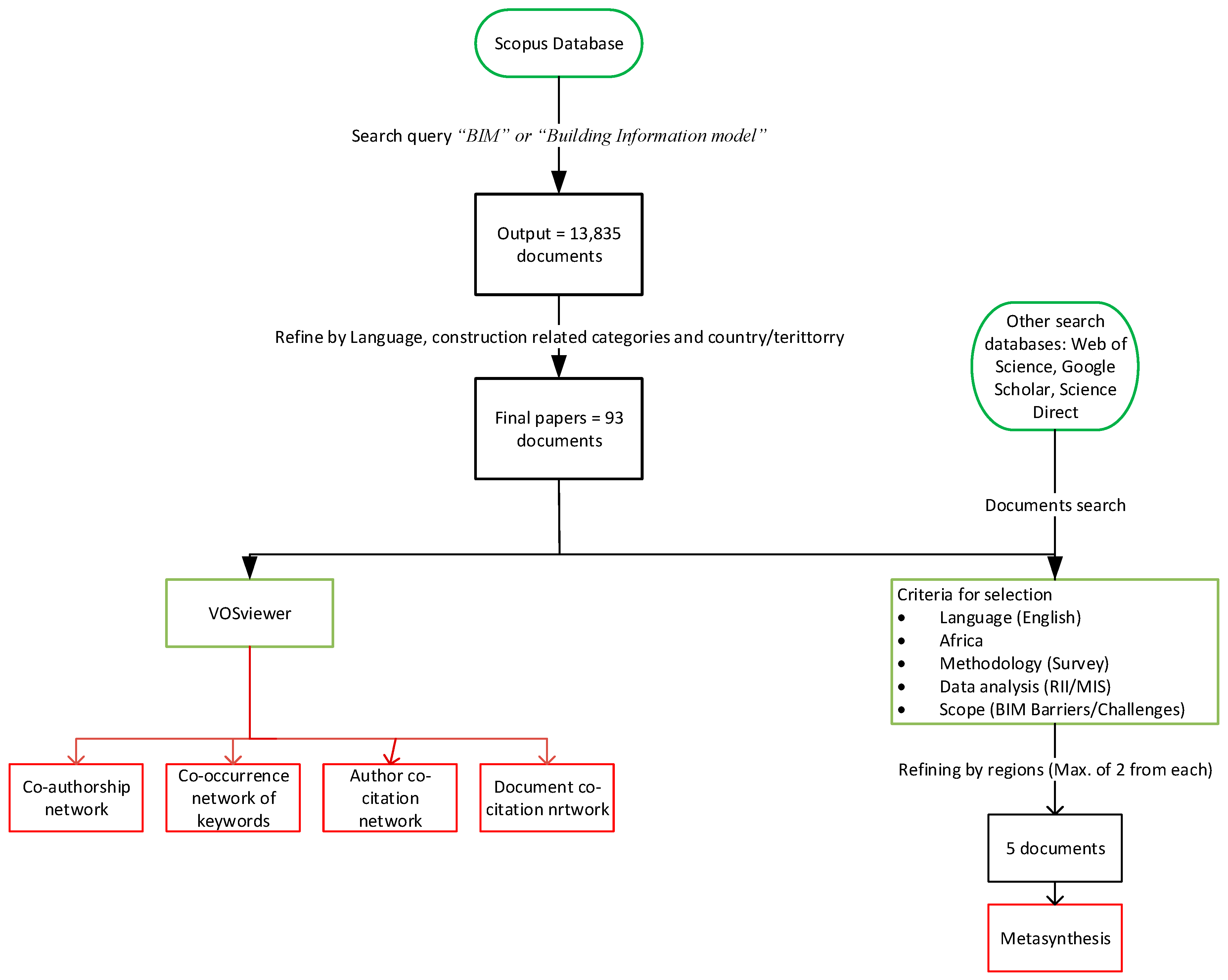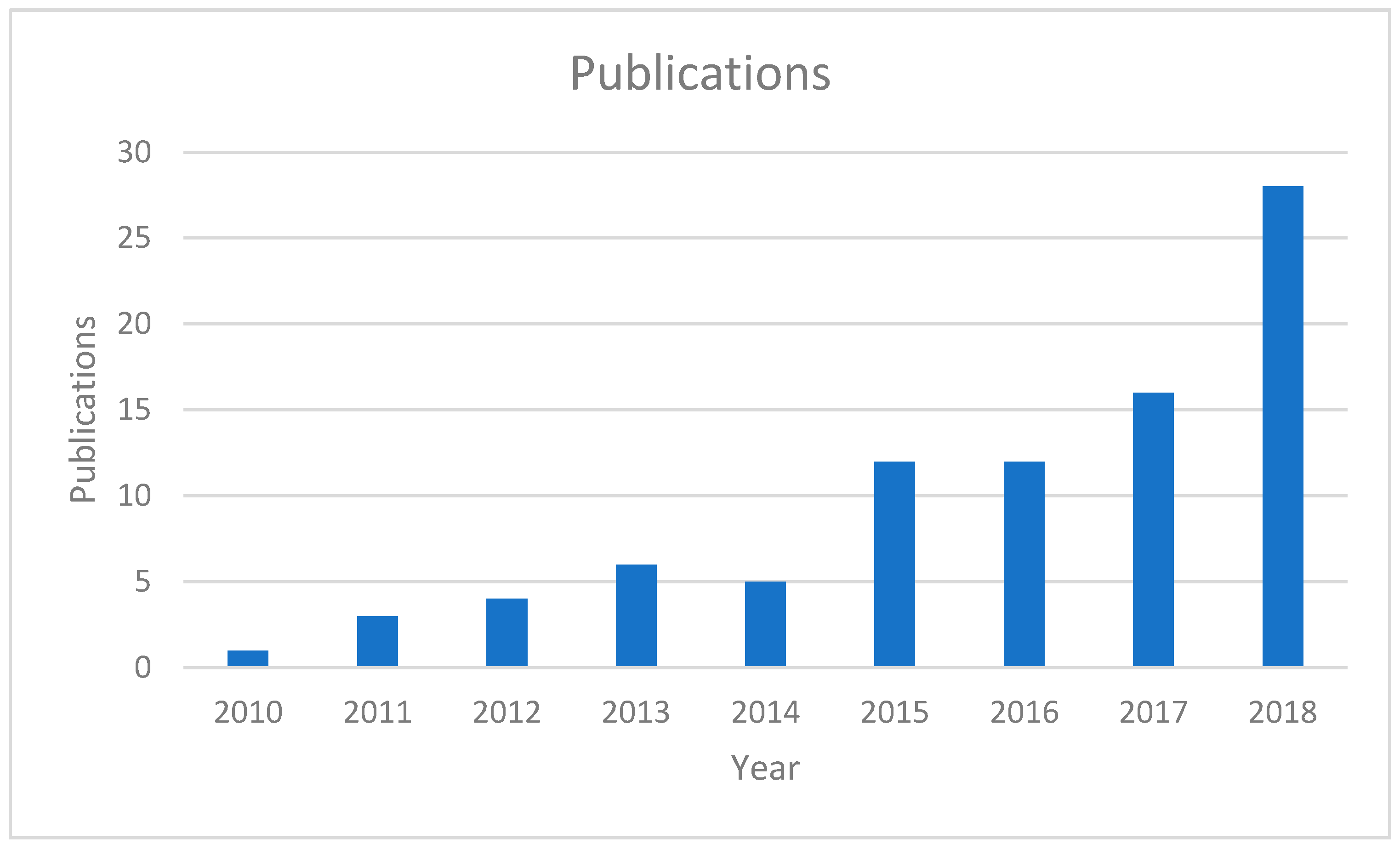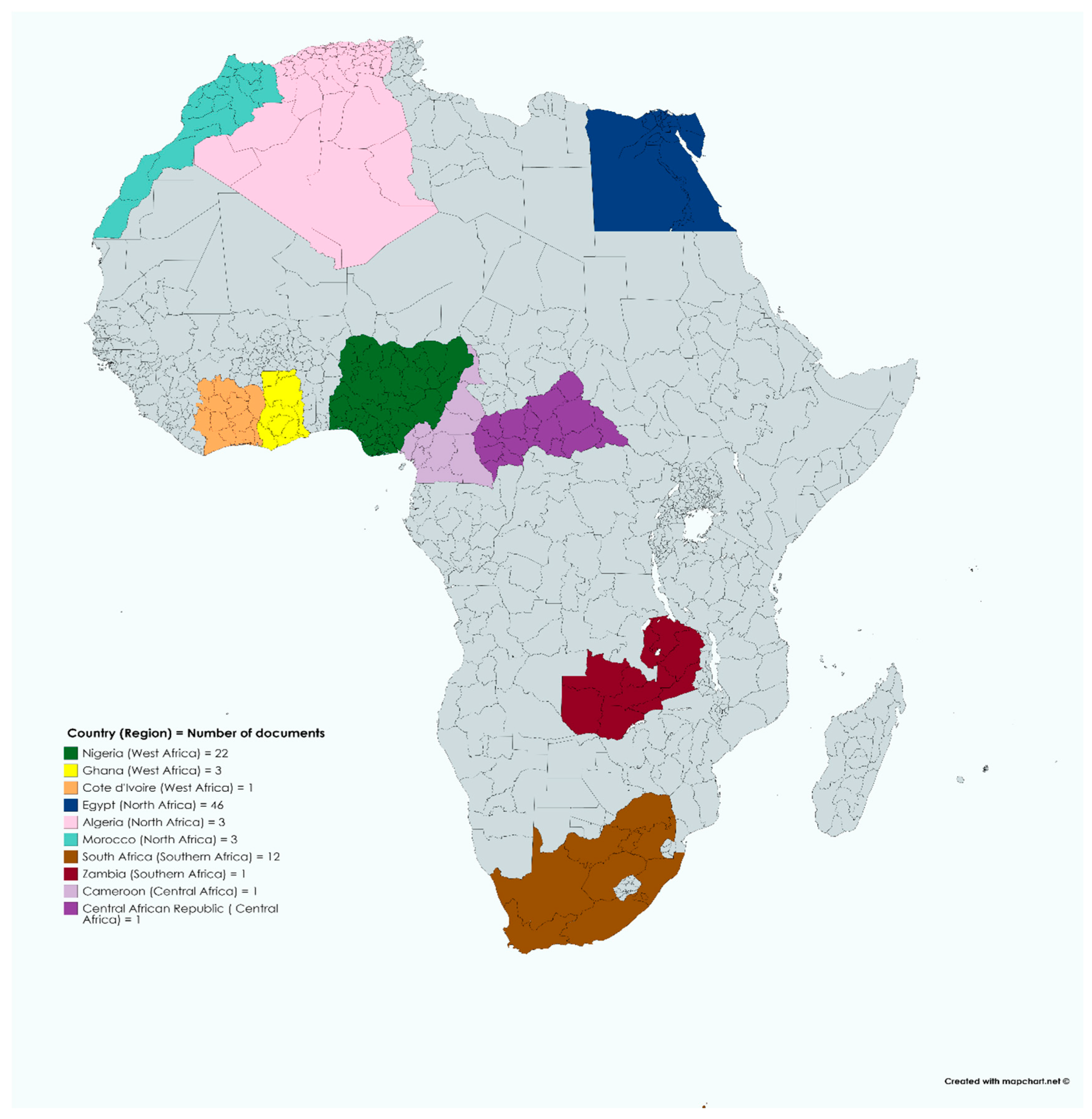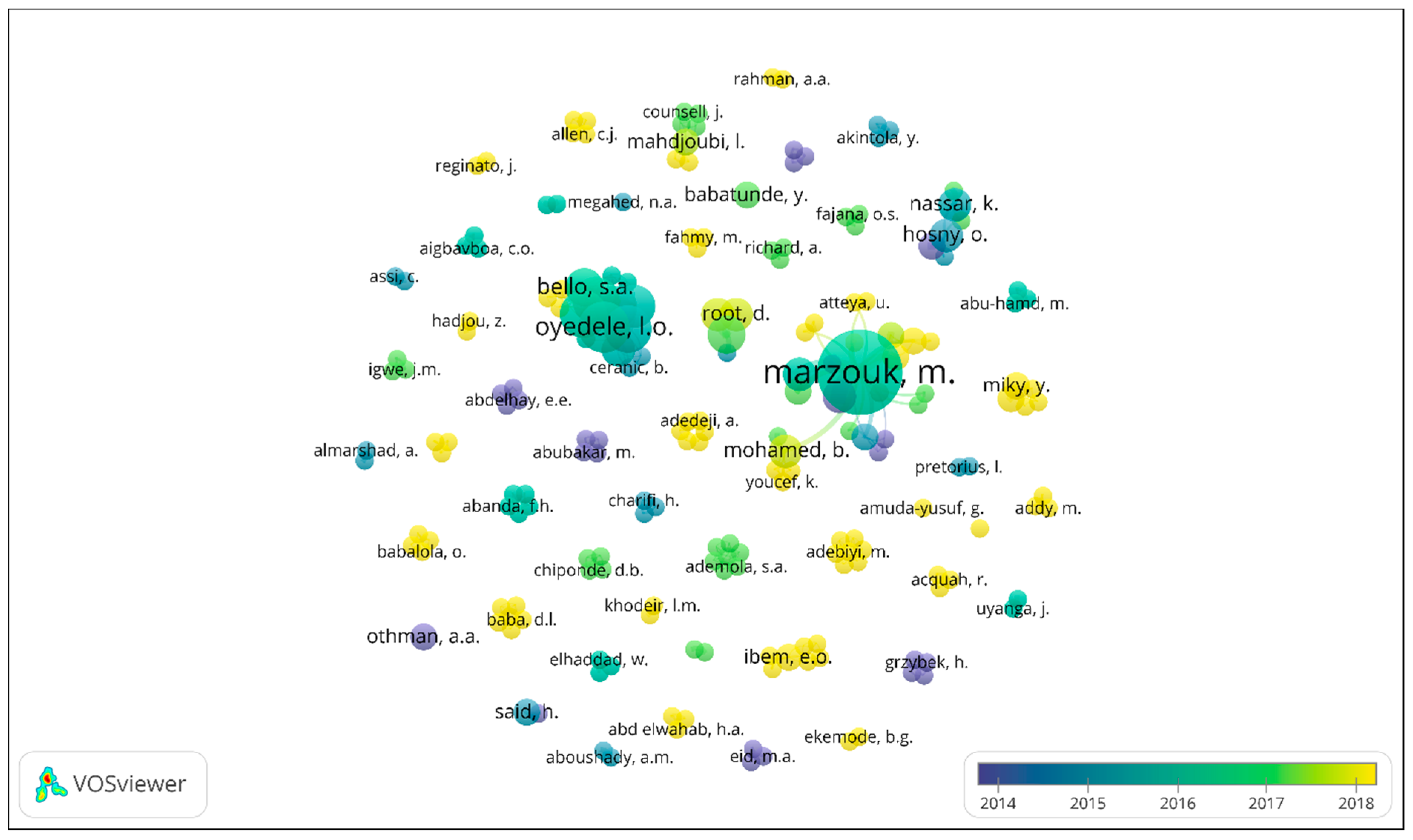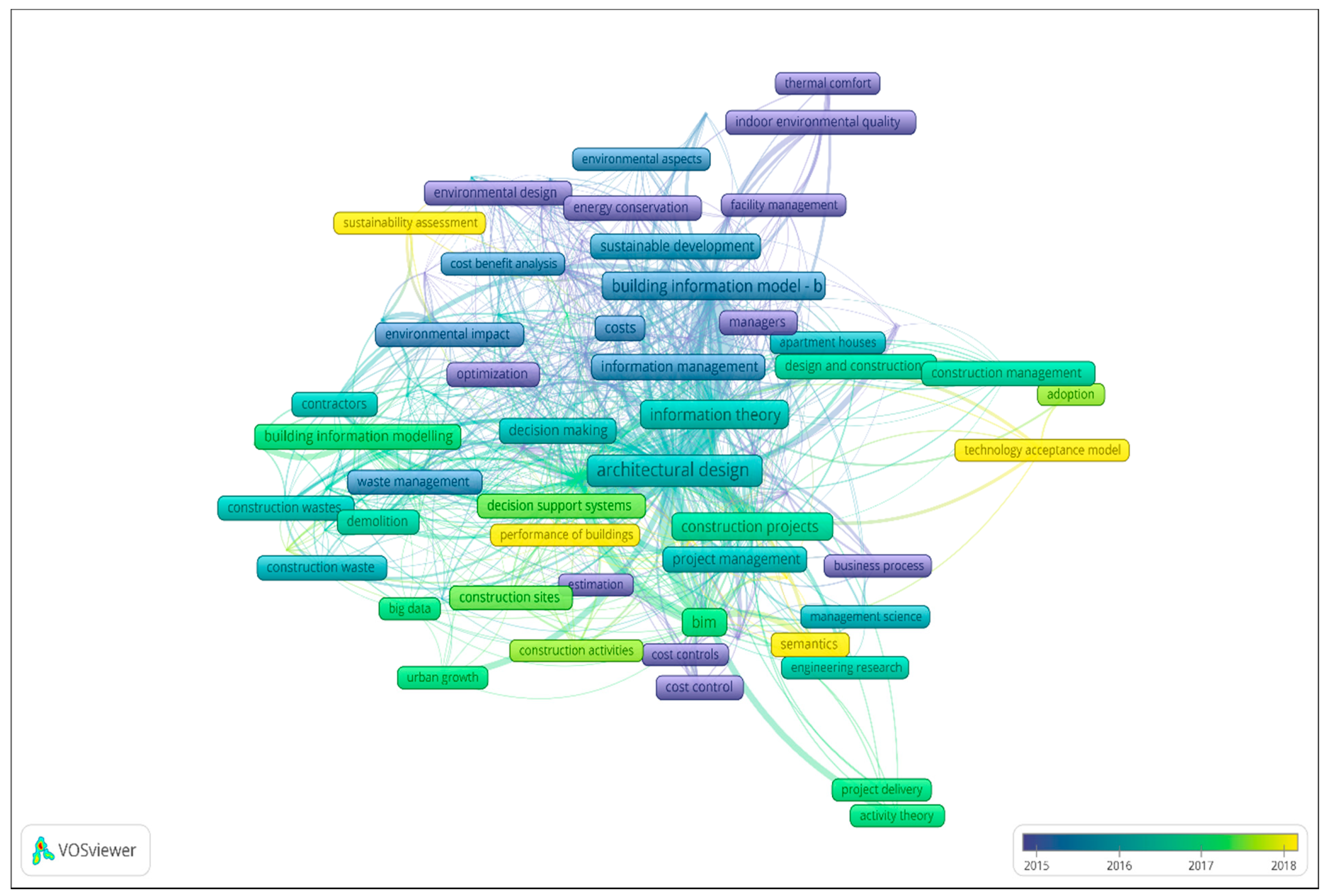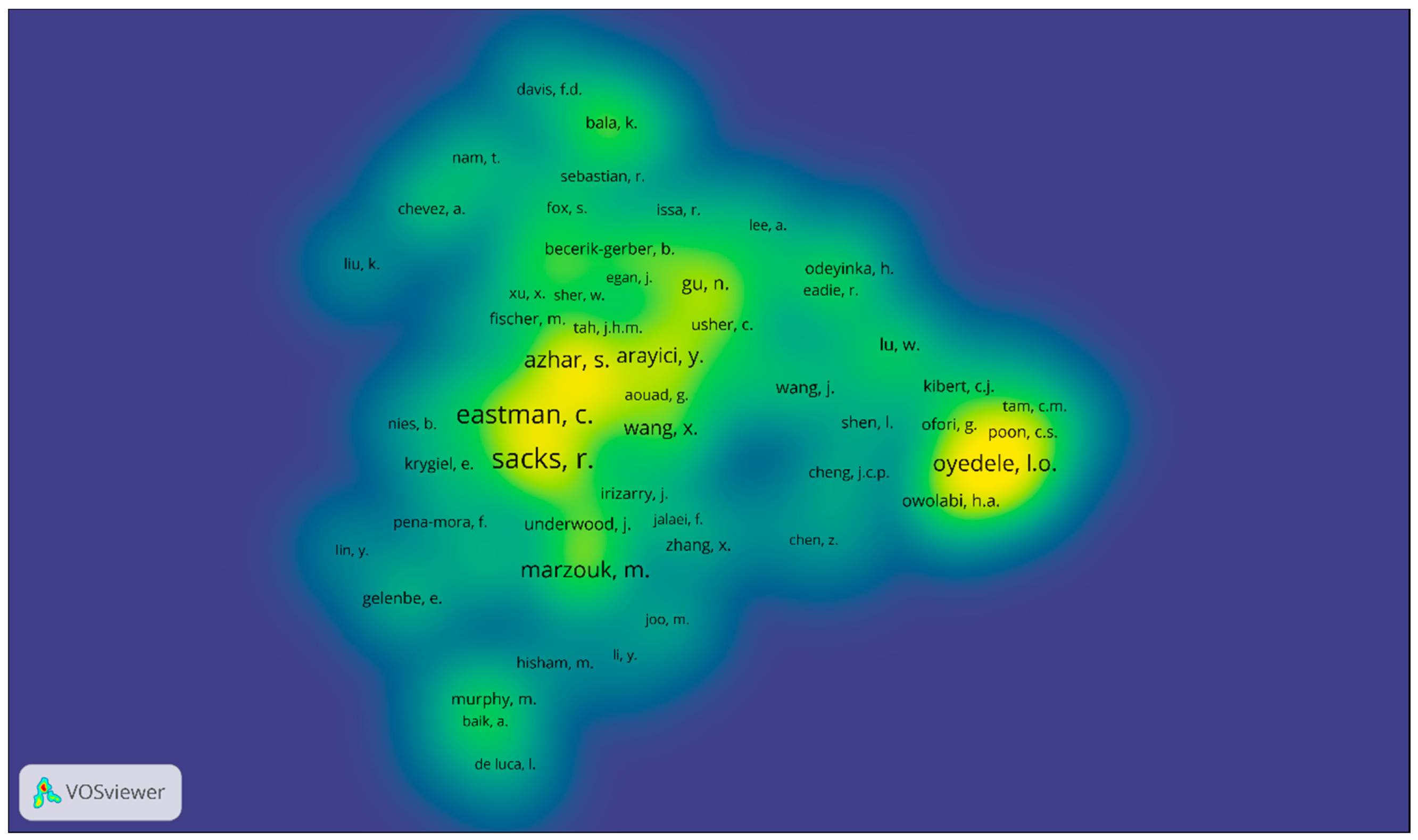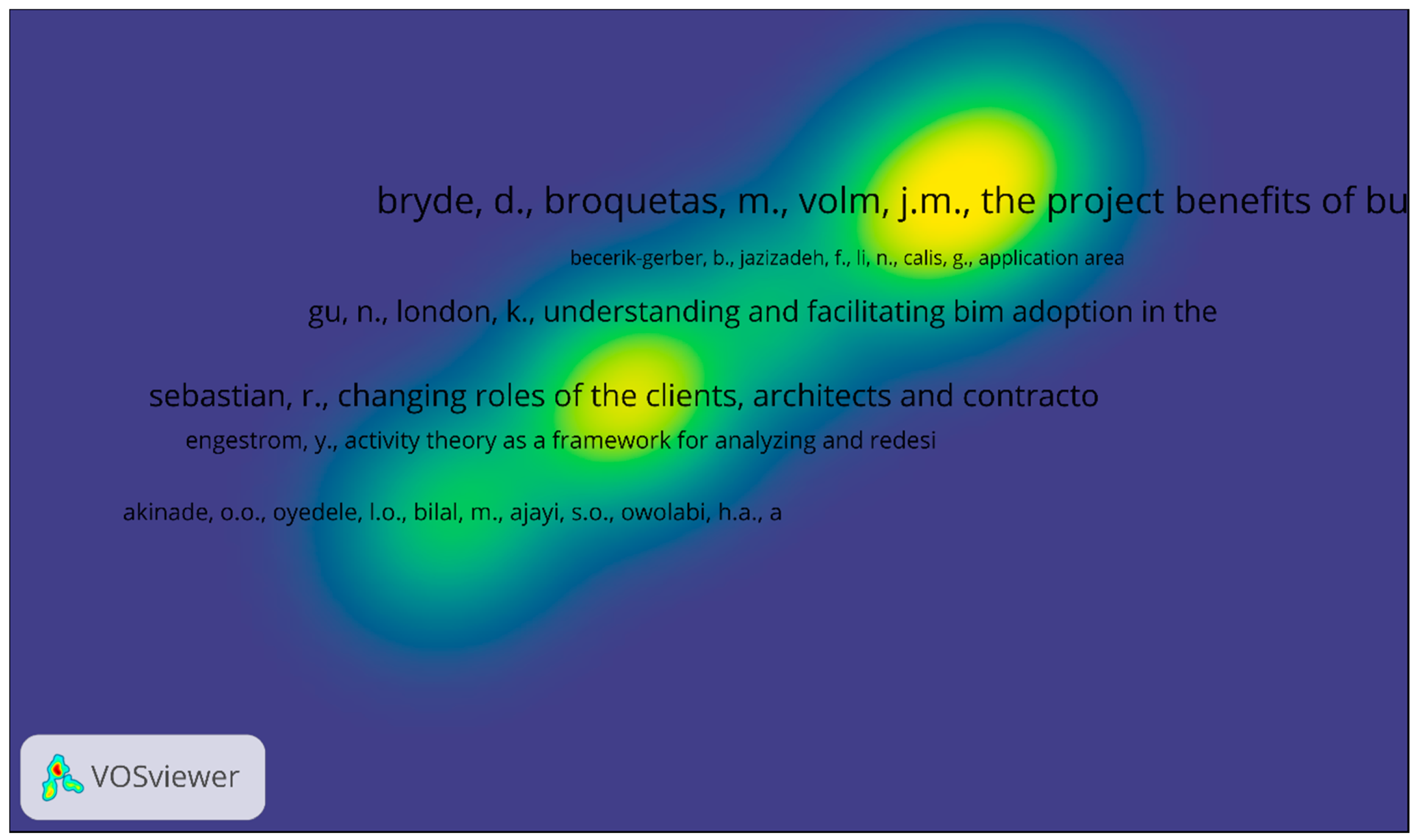1. Background of Study
Over the years, there have been reports regarding the low productivity in the Architecture, Engineering, and Construction (AEC) industry. This is partly due to the complex nature of the industry and the fragmentation of the activities. Latham [
1] and Egan [
2] asserted the fragmentation and the need for a more collaborative and integrated industry. Albeit, the industry is changing, however, the shift towards an integrated industry is slow and not moving as expected [
3]. The AEC industry is also synonymous with slow implementation of innovation when compared to the manufacturing industry; thus, it is not surprising that the construction industry is lagging behind the manufacturing industry, transportation industry, among other industries [
4].
Paradigms and technologies have emerged and been channelled towards achieving an integrated industry and improving the state of the industry over the last decades. Lean Practices, Sustainability, Prefabrication, Building Information Modelling (BIM), Business Process Reengineering (BPR), Total Quality Management (TQM), among others are being adopted and implemented in the construction industry to combat some of the major challenges encountered in the industry and affect its capability to achieve value for money.
The Building Information Modelling (BIM) is one of the developed paradigm shifts and it is a technology-enabled innovative means of virtually designing, constructing, and managing construction projects by simulating a virtual model [
5,
6]. Information that are related to the cost details, schedules, geometry, and geospatial relationships are available in the BIM model for different functionalities, such as auto quantity takeoff, clash detection, space management, energy simulation, scheduling, cost estimating, etc. This allows for the project stakeholders to efficiently collaborate throughout the lifecycle of the project [
7]. The BIM is not an independent technology but a technology-enabled process of collaboration, with approximately 90% process and 10% technology [
8]. Thus, Succar [
9] defines it as the interrelationship of policies, processes, and technologies generating a methodology of managing the building design and data in a digital format.
Adoption and implementation of BIM have been on the rise as a result of the benefits attached to it during the design, construction, and operation phase of the construction projects. Benefits, including lifecycle data management, saving time, improving quality, improving productivity, saving cost, and improving collaboration have been reported in extant studies [
10,
11,
12,
13,
14,
15]. Similarly, there has been a surge of BIM adoption in countries, organisations and projects [
16]. The United Kingdom (UK) government mandated the use of BIM on all public procured projects in a bid towards reducing 20% of the industry cost [
8,
17]; the move towards 33% reduction in cost, 50% reduction in time, 50% reduction in greenhouse emission, and 50% reduction in trade gap has been set for the construction industry towards 2025 [
18]. The mandate has dramatically impacted the United Kingdom’s construction industry BIM adoption. In the United States of America (USA), the US General Services Administration has pioneered the implementation of BIM on public projects [
17,
19], leading to a proliferation of BIM adoption in the country. The Building and Construction Authority in Singapore implemented the BIM Roadmap in 2010, with the aim that 80% of the construction industry will be using BIM by 2015, which contributes towards the bid of increasing the industry productivity by 25% [
20]. South Korea also mandated the use of BIM on projects over S
$50 million for all public projects. Similarly, countries, such as Malaysia, Hong Kong, Canada, Australia, and China, have embarked on various strategies towards the proper implementation of Building Information Modelling in their construction industries [
21]. Reports from McGraw Hill [
22,
23,
24] revealed the increase in BIM implementation in the United Kingdom, North America, Germany, and France. Gerges, et al. [
25] reported the increase in BIM implementation between 2013 and 2015 for Germany to be 72% from 37%, the US to be 79% from 55%, 71% from 39% for France, and 71% from 33% for Australia. The National BIM report (UK) corroborated that BIM adoption has increased to 60% in 2017 from 13% in 2011.
Consequently, there has been an increase in the studies of BIM in areas, such as adoption and implementation [
26,
27,
28,
29,
30,
31,
32,
33], challenges [
34,
35,
36,
37,
38,
39,
40,
41], application [
42,
43,
44,
45,
46,
47,
48], among others. Research studies have embarked on reviews of the growing research in Building Information Modelling (BIM) using a manual review, scientometric review, bibliometric review, or latent analysis. There are many studies regarding the manual review of BIM literature. Ghaffarianhoseini, Tookey, Ghaffarianhoseini, Naismith, Azhar, Efimova, and Raahemifar [
13] presented the benefits, challenges, and risk of BIM implementation and identified a lack of demand, cost, and interoperability issues as some of the barriers hindering BIM implementation. Wong and Yang [
49] reviewed BIM literature in two main directions of BIM for design, planning and construction, and BIM for post-construction. It identified the lack of attention on BIM for facility management (new and existing buildings) and asset management. Gu and London [
50] analysed the state of BIM in the AEC with respect to product, processes, and people. It concluded that the level of adoption varies from country to country, discipline to discipline, and client to client. The study also identified the need to address the technical and non-technical issues hindering BIM adoption and a BIM decision framework was developed. Volk, et al. [
51] reviewed over 180 publications on BIM implementation in existing buildings and revealed a low level of implementation, which is a result of issues that are related to modelling and conversion efforts, handling of uncertain BIM data, and the updating of BIM information. The nexus of BIM and green buildings was reviewed and Lu, et al. [
52] developed ‘Green Buildings Triangle’ taxonomy. The study also underscores the need to understand BIM and green buildings nexus based on the three-dimensions of project phases, green attributes, and BIM attributes. Similarly, Bradley, et al. [
53] presented a review of BIM for infrastructure projects with 259 articles to determine the development trends and gaps.
Bibliometric and latent semantic analysis have also been adopted in the review of BIM literature. Yalcinkaya and Singh [
54] adopted a latent semantic analysis to review 975 BIM papers and to identify the core areas. Li, et al. [
55] reviewed 1,874 BIM articles; Santos, et al. [
56] reviewed 381 papers between 2006 and 2015; and, Olawumi, et al. [
57] reviewed 445 BIM articles using bibliometric analysis to identify the BIM research trends and themes. Similarly, the scientometric review has been used to review BIM literature. Zhao [
58] presented a global review by analysing 614 articles while using the ‘CiteSpace’ software to identify the trends and research themes. He, et al. [
59] and Oraee, et al. [
60] adopted a scientometric review to analyse BIM articles on managerial aspects of BIM and BIM-based Construction Networks (BbCNs), respectively. Hosseini, et al. [
61] adopted it to review BIM literature and identified research themes. Notably, Saka and Chan [
62] analyzed 914 BIM articles that were taxonomically based on the six continents of the world and revealed that there are differences in BIM development across the continents.
Extant reviews of BIM are informative, as they provide the trends of BIM research from myriads of BIM papers. However, they often adopt a singular and global view of BIM development, despite the importance of these reviews. These reviews do not reflect the variance in the BIM development, but rather presents a holistic status quo of BIM research. Jung and Lee [
63] revealed that BIM adoption varies across the six continents of the world. It also revealed that Africa, South America, and the Middle East are lagging, whilst North America, Europe, Asia, and Australia are clearly ahead in BIM adoption. This is supported by the global taxonomic review of BIM by Saka and Chan [
62]. Gu and London [
50] corroborated this by asserting that BIM development varies from country to country, discipline to discipline, and client to client. Succar [
9] also revealed that BIM use varies across regions and countries as a result of the different levels of maturity.
This study presents a scientometric review and metasynthesis of BIM research in Africa, which is often underrepresented in the existing studies. It aims to track the evolution of BIM study in the regions of Africa using the scientometric analysis coupled with metasynthesis. Additionally, to report the status of BIM adoption and implementation in these regions, and the challenges facing the proliferation of BIM in Africa at large, this study seeks to contribute to the developing body of literature on BIM from this continent and provide a clear status quo of BIM and the future directions of development in Africa.
2. The Architecture, Engineering and Construction (AEC) Industry in Africa
The African Continent consists of five regions, which include Northern Africa (Algeria, Egypt, Libya, Morocco, South Sudan, Sudan, Tunisia, and Western Sahara), Eastern Africa (Burundi, Comoros, Djibouti, Eritrea, Ethiopia, Kenya, Rwanda, Seychelles, Somalia, Tanzania, and Uganda), Central Africa (Cameroon, Central African Republic (CAR), Chad, Democratic Republic of Congo (DRC), Equatorial Guinea, Gabon, Congo-Brazzaville, Sao Tome, and Principle), West Africa (Benin, Burkina Faso, Cape Verde, Côte d’Ivoire, the Gambia, Ghana, Guinea, Guinea Bissau, Liberia, Mali, Mauritania, Niger, Nigeria, Senegal, Sierra Leone, and Togo), and Southern Africa (Angola, Botswana, Lesotho, Madagascar, Malawi, Mauritius, Mozambique, Namibia, South Africa, Swaziland, Zambia, and Zimbabwe), with an estimated population of 1.216 billion as at 2016 and which is expected to double by 2050 [
64]. The AEC industry is expected to grow at a fast rate in the next five years and will become a major player in the global construction [
64].
According to the Deloitte [
65] report, 139 projects with a total project value of
$187.1bn were recorded in Eastern Africa, accounting for 28.8% of the projects on the continent. Key projects, such as Konza technology park (Kenya), with worth of
$14.5bn, Bagamoyo mega project (Tanzania), with value of
$11.0bn, and Nairobi–Naivasha Rail Project (Kenya), with value of
$6.2bn, were identified and the report revealed Kenya, Ethiopia, Tanzania, and Rwanda as the leading countries in the AEC of this region. Private domestic firms and Chinese firms undertake most of the construction in this region, while Indian, Italian, Portuguese, and Middle East firms undertake other works. Similarly, 103 projects with a total project value of
$125.14bn were recorded in Southern African, accounting for 21.4% of the projects on the continent. Key projects, such as Kambo Block 32 (Angola), with worth of
$16.0bn, Kushile power station (South Africa), with value of
$15.2bn, and Medupi power station project (South Africa), with value of
$13.2bn, were identified and the report revealed South Africa, Angola, and Mozambique as the leading countries in the AEC of this region. Chinese firms and Private domestic firms mostly undertake construction projects, while Portuguese, South African and Australian firms undertake other projects [
65]. Cameroon and DRC top the list of AEC industry in the Central Africa region. A total project value of
$26.9bn from 26 projects was reported and key projects, like Ngaoundal & Minim-Martap (Cameroon), with the worth of
$6.0bn, Mbalam-Nabeba (Cameroon), and Zanaga (Congo-Brazzaville), both worth
$4.7bn each, and Kamoa-Kakula (DRC), worth
$2.9bn, were identified [
65]. Nigeria and Ghana dominate the AEC industry in Western Africa, and with key projects from Nigeria, such as OML 130, which is valued at
$16.0bn, Olokola Deep-sea Port, valued at
$12.0bn, and the Dangote refinery, valued at
$12.0bn. There are 106 ongoing major projects totalling
$82.8bn in this region and it accounts for 21.8% of all ongoing projects on the continent. Chinese firms dominate this region, followed by private domestic firms [
65]. The Northern Africa AEC industry accounts for 109 ongoing projects totalling
$148.3bn and it represents 22.6% of ongoing projects on the continent. Key projects, such as El-Dabaa Nuclear Power Plant (Egypt), valued at
$30bn, East-West Highway Project (Algeria) valued at
$11.2bn, and Tahrir Petrochemical Complex (Egypt), valued at
$10.6 billion. Private domestic firms dominate the construction activities in this region and other firms are from China, the Middle East, Spain, and South Korea [
65].
There is an infrastructural deficit in the region despite the seemingly positive performance of the African AEC [
66]. The deficit needs to be addressed for the continent to structurally transform and it serves as a place of market integration [
67]. The Africa infrastructure is lagging that of other developing countries and the deficit is growing wider. An estimated investment of US
$38 billion per year, coupled with US
$37 billion for operations and maintenance, is needed to redress the deficit [
68]. The challenge facing the continent is compounded by the slow rate of technology adoption in the AEC [
69]. Ogwueleka and Ikediashi [
69] asserted that the proliferation of technology in the African AEC would be of immense benefits.
6. Discussion of Review Findings
The BIM research on this continent has been on the increase, evidently from the increase in the number of publications over the last few years. There are more publications from North Africa, West Africa, and Southern Africa than East Africa and Central Africa. Countries, such as Egypt, Nigeria, and South Africa, stand out in the BIM research on this continent. However, less than 20% (10) of the countries in Africa (54) have research publications that are indexed on Scopus. This further shows that BIM diffusion in Africa is still at an early stage and this resonates with the findings of Jung and Lee [
63], Ogwueleka and Ikediashi [
69], and Saka and Chan [
62]. In most of the represented countries in this study, the level of awareness is more than 50%, except for Libya, Zambia, and Cameroon (the level of awareness is not representative, as purposive sampling was adopted in the study selected from this country). Consequently, BIM awareness is increasing in these countries, albeit at a very slow pace in Africa as a whole. The level of awareness in Egypt stands out (above 90%) and this could explain the high number of publications from this country. Nigeria also follows the same trend, with a high number of publications and awareness in the country’s AEC industry. Thus, there seems to be a relationship in the research and development of BIM and the level of awareness in the AEC industry. However, a high level of awareness does not connote a high level of implementation.
The visualized author network corroborated the fact that BIM research is still in the infancy stage on the continent. There are only two established clusters with other researchers that are scattered around and this signifies the lack of collaboration between researchers on this continent. The author network also depicted that most of the research in recent years on this continent are from the researchers scattered around the network. The co-occurring words relate around sustainability and BIM adoption and implementation in a similar way to the cited references. The research in this area leans towards adopting theoretical lenses, as shown by the keywords, such as ‘Technology acceptance model’ and the citation of documents, such as Davis, et al. [
108] and Davis [
105]. This differs from the findings of Hosseini, Maghrebi, Akbarnezhad, Martek, and Arashpour [
61] that identified the lack of theoretical lenses in BIM studies and the greater focus on the technology aspect of BIM. Authors, such as Eastman Chuck, Sacks Rafael, and Azhar Salman, are most cited authors on this continent. This is similar to the findings of Saka and Chan [
62], Zhao [
58], and Hosseini, Maghrebi, Akbarnezhad, Martek, and Arashpour [
61]. The diversity in the location of these top cited authors shows that BIM research is global [
58]. Eastman Chuck is the most cited author, and this could be partly explained by his contributions to the BIM research and it is often tagged as ‘Father or Pioneer of BIM’ [
62,
109,
110].
Metasynthesis of the five selected studies across the continent shows that people/process-related barriers are the major challenges of BIM in Africa and this reflects the process/people-oriented nature of BIM. This is followed by economic-related challenges and technology-related challenges. The people/process-related challenges include a lack of awareness, lack of training, lack of demand, lack of government support etc. Thus, there is a need for an increase in awareness that would impact the implementation of BIM in the long run. Additionally, there is a need for a change in orientation of the stakeholders in the AEC industry towards BIM; the stakeholders need to be less resistive of BIM and to adopt it. There seems to be no clear government mandate or policies regarding BIM on this continent as seen in developed countries. The BIM push on this continent leans towards a ‘bottom-up’ approach in the absence of government mandate.
There are inadequate empirical studies on the benefits of BIM in convincing the stakeholders to invest in BIM. Most of the stakeholders doubt the positive return on BIM investment and perceive investing in BIM as high risk. This challenge is compounded by the high cost of software, and training leading to high cost of BIM investment. The high cost of implementation is frequently reported as a major bottleneck for BIM proliferation and this could be partly explained by the high presence of small and medium enterprises (SMEs) in the African AEC industry. These SMEs are characterised by the limited resource to invest in BIM and perceive BIM as a risky investment. However, SMEs stand to gain more from BIM adoption and implementation than large firms due to their unique attributes [
30,
111]. Thus, studies of BIM in African (SMEs and large firms) context is a necessity to allay the fear of the stakeholders and for the proliferation of BIM in the African AEC industry, as the SMEs are the backbone of the economy [
112]. These studies would help in integrating the ‘digital-divide’ [
3] between ‘BIM compliant’ large firms and ‘BIM complaint’ SMEs. Technology-related challenges, such as interoperability, lack of BIM standard, and inadequate infrastructure (e.g., internet connection and power supply) are severe in hindering the BIM diffusion in the African AEC industry.
Figure 8 presents the summary of the BIM development in Africa.
7. Conclusions
This study presented a scientometric review and metasynthesis of BIM in the African AEC by making use of BIM publications from the Scopus search engine (scientometric) and other databases (metasynthesis). It identified the publication trend over the years and the publication distribution across different countries and regions on the continent. North Africa (Egypt) has the highest number of publications and high level of BIM awareness, which differ from other regions and countries. West Africa, South Africa, and East Africa are also progressing, whilst Central Africa seems to be lagging behind in BIM adoption, implementation, and research. Process and People related challenges are perceived as the most severe challenges hindering the proliferation of BIM, followed by economic-related barriers and technology-related barriers. There exists a genuine need for an increase in awareness of BIM and more research studies on BIM benefits, BIM implementation, and adoption, as these would lead to an increase in the adoption and implementation of BIM. Additionally, the government impetus could help drive BIM innovation in the African AEC industry, as observed in developed countries.
The African AEC industry needs to embrace and adopt innovations, such as BIM, in order to be equipped to remedy the infrastructural deficits and prepare for the population boom on the continent during which there will be a strong demand for the AEC industry to supply infrastructure facilities more than ever. Additionally, the adoption of BIM provides several profound benefits that would be of aid to the AEC industry that is constantly facing significant challenges [
113,
114,
115]. The adoption of innovations, such as BIM, would no longer be a need but a necessity for the survival of firms.
Despite the significance of this study, it has own limitations. The dataset that was extracted from Scopus search database was used for the analysis; therefore, the study may be affected by Scopus’s coverage of publications. Also, only documents that were published in English were considered, and there may be other documents that are published in other languages. These limitations could serve as fertile areas for further research. In conclusion, BIM adoption and implementation in the African AEC industry is underrepresented in extant studies [
116] when compared to those of other continents that are often made available by McGraw-Hill reports [
22,
23,
24,
117] and NBS [
16]. A further area of studies could consider empirical surveys of BIM in the African AEC industry across the various regions.
